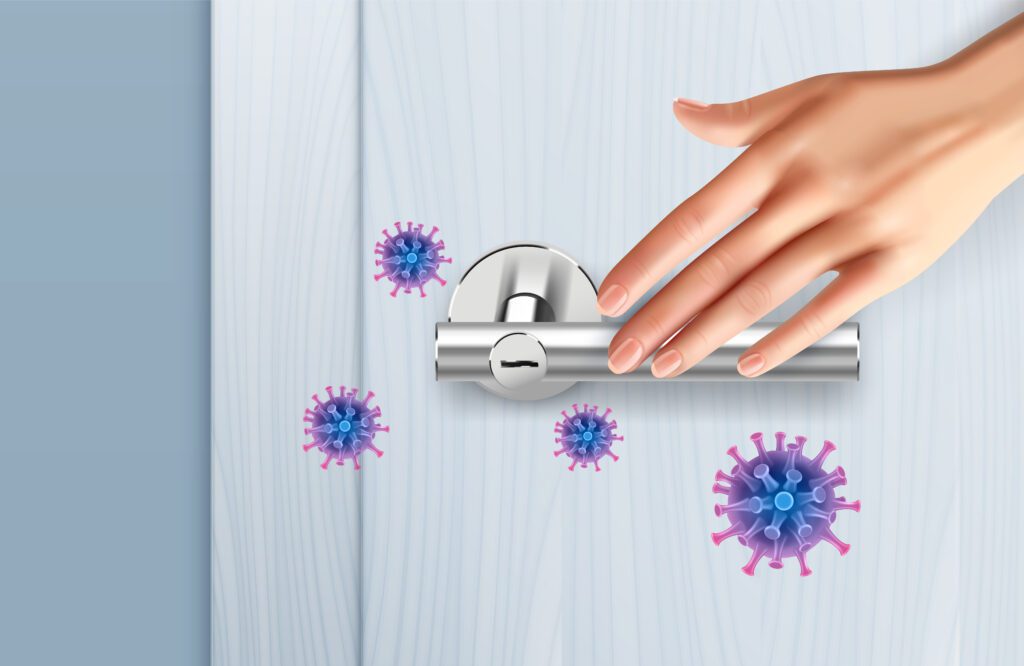by Gertrud U. Rey


Recent news headlines are fueling public fears about possible transmission of monkeypox virus through contact with contaminated objects like bedding or clothing. However, data generated using environmental sampling methods indicate that the likelihood of this type of transmission is very low.
In a study involving a two-person household in Utah in which both residents were infected with monkeypox virus, the investigators entered the home to obtain samples while the patients were present. The investigators then identified and swabbed various objects that had been touched frequently; including furniture, toilet handles, light switches, and remote controls. They subsequently processed the swab samples and performed PCR and cell culture analyses to detect the presence of monkeypox virus DNA and infectious monkeypox virus. Out of 30 samples tested, 21 yielded positive results by PCR, confirming that these 21 objects were contaminated with monkeypox virus DNA. However, none of the PCR-positive samples yielded any detectable virus in cell culture, suggesting that there was no infectious virus on any of the tested surfaces in that household.
A second study involved a one-person houshold in Texas whose resident had been hospitalized with monkeypox virus infection. On day 15 after the patient had left the home, the investigators entered the house and obtained 31 swab samples from various household objects similar to those tested in the Utah home. PCR analysis revealed that 27 of the tested objects were contaminated with monkeypox virus DNA. Cell culture analysis showed that 7 of these 27 samples also contained viable virus, with six of the virus-positive samples originating from porous surfaces like bedding and clothing, and only one originating from a non-porous surface – the top of a coffee table. When the authors determined the concentration of virus in each of these seven samples using a standard titration assay, they found that only one of the samples produced a quantifiable amount of virus – a swab from an article of clothing that had been in prolonged, direct contact with active monkeypox lesions. In contrast, the quantities of virus isolated from the other six samples were all below the detectable limit of the assay, suggesting that even if an object is contaminated with monkeypox virus, the amount of virus is probably lower than the minimal infectious dose needed to establish a successful infection in a person.
A popular historical anecdote involving transmission of pox virus through inanimate objects describes how the US Army attempted to reduce the Native American population by gifting them smallpox virus-contaminated blankets. However, there are no reports or evidence indicating that this strategy actually worked, suggesting that it was probably ineffective. In fact, some historians cast doubt on whether this incident even took place.
It is possible for pox viruses to remain viable on surfaces for long periods of time, but the conditions have to be just right. Studies involving variola virus (which causes smallpox) have shown that viral particles can stay viable on contaminated surfaces for up to 13 years if they are maintained at low humidity, low temperature, and in the absence of UV radiation. The authors of the Utah home study note that the residents cleaned and disinfected their home routinely during their illness, a practice that likely resulted in reduced viability and/or inactivation of infectious virus on all of the tested objects. In contrast, no such cleaning activities were noted for the Texas home. In addition, all windows of the Texas home were covered with closed blinds, a condition that likely reduced exposure to UV radiation and probably contributed to the preservation of viral particles.
Although it is possible to become infected with monkeypox virus by touching contaminated surfaces, the potential for this type of transmission appears to be limited, and the risk of acquiring monkeypox from hotel sheets, towels, or plane seats is probably very low. Monkeypox virus is transmitted most effectively through direct (i.e., skin-to-skin) contact with lesion material or inhalation of respiratory droplets during prolonged face-to-face interaction with an infected person.
[The material in this blog post is also covered in Catch This Episode 39.]

Informative article!
Dear sir/madam
I would like to ask question,
What type of cell line are used for monkey pox isolation?
What about the sensitivity of cells used?